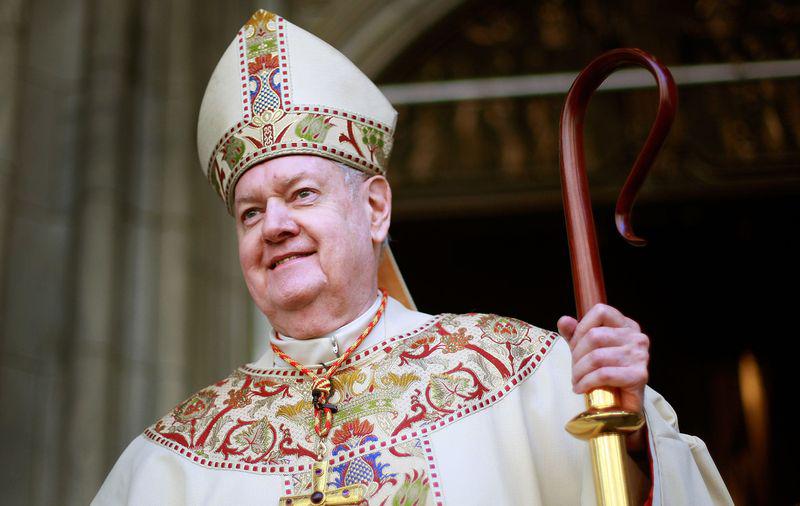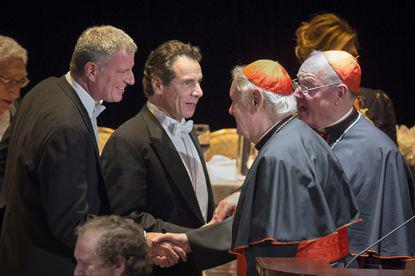|
Bridgeport Diocese report on sex abuse among priests blames former Archbishop Edward Egan; nearly 300 individuals allegedly abused by 71 priests since 1953
By Dave Altimari And Amanda Blanco
A scathing report released Tuesday by the Roman Catholic Diocese of Bridgeport on the alleged sexual abuse of hundreds of victims by clergy since the early 1950s blames former bishops Edward Egan and Walter Curtis for violating state law, destroying records and either outright ignoring or inadequately responding to “an unfolding crisis.” As the number of priest abuse victims piled up, church leaders were more concerned about protecting assets and avoiding “scandalous news articles” than protecting children and removing priests, the report found. The report, compiled by former state Superior Court Judge Robert Holzberg, was particularly harsh on Egan, who went on to become Archbishop of New York. The report found 281 victims allegedly abused by 71 priests or about 5 percent of the total number of priests that have served in the diocese. More than $56 million was paid to victims in legal settlements. “The priests who committed these ghastly acts engaged in criminal acts,” Holzberg said at a Bridgeport press conference Tuesday. A total of 10 priests, including Laurence Brett, Raymond Pcolka and Martin Federici, accounted for 61 percent of the abuse cases. The report concluded Egan was “profoundly unsympathetic, inadequate and openly inflammatory,” whose primary responsibility was “preserving the assets and reputation of the diocese” rather then the well-being of sexual abuse survivors. Holzberg also questioned Egan’s “disturbing” decisions to promote some of the worst-known abusers rather than discipline them or remove them completely. Of the nine priests accused of the most sexual assaults, Egan promoted five of them. Holzberg was hired last October by the current Bishop Frank Caggiano to oversee a comprehensive review of all sexual abuse claims against priests in the Bridgeport Diocese since it was formed in 1953. “The abuse ranged from lewd behavior in front of victims to violent assaults,” the report states. “It had many profound effects on the victims over and above the sexual abuse itself, including long-term mental health problems, fear of retaliation after the fact and estrangement from their families and from their religious faith.” The report stated that “diocesan leadership” was aware of the abuse since as early as 1953. “Until the early 2000s, the collective response of diocesan officials to the sexual abuse crisis was inadequate in nearly every way, but the single gravest moral and legal lapse was the consistent practice of Bishops Lawrence Shehan, Walter Curtis, and Edward Egan — over four decades — of leaving abusive priests in service, and thereby making it possible for them to continue committing abusive acts.” Egan, who later was named a cardinal and became archbishop of New York, died in 2015. Curtis, who was the founder of Sacred Heart University, died in 1997. Despite leading the diocese from 1988-2000 when the priest sex abuse scandal exploded nationally, Egan only petitioned the Vatican to have two priests laicized. It was only after he left that his successor, Bishop William Lori, petitioned to laicize nine more priests. Victims groups reacting to the report said they weren’t surprised at the findings since many of the priests are well-known pedophiles and that more investigation needs to be done of wherever Egan was in charge. Some of them said the report shows that a full, statewide accounting by a grand jury is needed. “What is disturbing is that the men singled out in this report, including former Archbishop Edward Egan, all had high level positions in other dioceses, meaning that their callous disregard for children and survivors as recognized in Bridgeport was likely experienced by survivors around the country,” said Gail Howard, the director of the Connecticut chapter of Survivors Network of those Abused by Priests (SNAP). “Every diocese where these men served should be subject to a full investigation by law enforcement officials to determine if any of these cover-ups can be criminally prosecuted,” she added. The list of accused priests worked at parishes throughout Fairfield County, from Bridgeport to Greenwich. A spokesman for Gov. Ned Lamont said the governor was reviewing the report. Chief State’s Attorney Kevin Kane said he was also paying close attention to the findings. “We will ... certainly investigate allegations made by victims,” Kane said, but he noted that Connecticut does not allow grand juries to hand down indictments. “We don’t have a statute that would permit us to have an ongoing grand jury in the manner Pennsylvania did, and we wouldn’t be inclined to investigate crimes that haven’t been reported by victims or parents of victims.” Caggiano also said that the diocese has a “zero tolerance” for abuse. “We are committed to ensure that this grave crime and grave sin will never again happen in our midst,” he said. “The church has been changed perhaps for the rest of our lifetimes. ... It is a wound that will take a very long time to fully heal,” Caggiano said. “My heart goes out to all those who were harmed and victimized. “I am deeply sorry for that betrayal. “When you have a wound, you have to clean it out completely before you can heal. This wound will take a very long time to heal.” Holzberg said investigators have not identified any reports of abuse since 2008. Investigators interviewed more than 50 witnesses, including about a dozen survivors of clergy sexual abuse, current and former bishops, priests, lawyers and others. The report says Egan failed to remove priests after allegations and sought to “preserve the patrimony or assets of the church” and avoid media coverage. “Bishop Egan failed to view clerical sexual abuse as what it is and was and is ... a legal crime. Instead, he viewed it as a lapse of judgment.” Among the 71 priests identified as having allegedly abused minors sexually, 41 were determined to be “credibly accused of abusing minors.” All of these priests have been removed from the ministry and are listed on the diocese website. Another 10 were determined to be “not credibly accused” but who were the subject of settlement payments by the diocese. Holzberg said that he has recommended the diocese’s Sexual Abuse Review Board take another look at those cases. Caggiano said that process has already begun. Another 19 priests were found to be not credibly accused because of a lack of evidence or to have pending cases before the diocesan review board. Many of those cases are either very old — the report identifies abuse cases going back to 1946 — or the priests are dead. Caggiano announced that he was hiring Holzberg last October on the heels of the release of a Pennsylvania grand jury report that detailed horrific claims of priest sexual abuse cases in that diocese. In Pennsylvania, the attorney general’s office did an 18-month investigation that covered six of the state’s dioceses — Allentown, Erie, Greensburg, Harrisburg, Pittsburgh and Scranton. The grand jury reviewed more than 2 million documents, including from the “secret archives” — files that church leaders held from the public for decades. Holzberg and his team were given access to more than 250,000 documents in the so-called “secret archives” to which only the bishops had access. They spent a year on the investigation, hiring some outside experts to assist. The majority of the abuse took place in the 1960s and 1970s. Many specific incidents of abuse were known to diocesan officials at the time they occurred, or became known while the priests were still living. The victims, most of them male, were between the ages of 5 and 18, Holzberg said. Most of the abuse occurred when the diocese was led by Bishop Curtis. “Bishop Curtis was undisguisedly indifferent to clergy sexual abuse in the diocese, not understanding or acknowledging its scope, and abdicating virtually all responsibility to his subordinates for responding to it,” the report stated. “Bishop Curtis did not remove abusive priests from service, and even allowed many to be reassigned to new parishes. By not removing them, he made possible continued abuse of additional victims.” In one example cited by the report, Rev. Joseph Moore from the Our Lady of Assumption Parish in Westport, often took teenagers on camping and ski trips during the 1970s. Moore’s abuse and the response of the diocese had “long-term impacts” on the victims. “One survivor credibly alleges that he was repeatedly molested by Father Moore, whom he had considered a friend and confidant, in multiple episodes during youth group outings. He relates having had to hide from Father Moore in a friend’s tent during one trip and in a closet during another, and being ‘terrified’ that Father Moore would find him,” the report stated. “Father Moore threatened to kill me, and I believed him.” The report further states that “instead of being removed from service after the ski trip incident, Father Moore received a transfer, after a few months in an alcohol rehabilitation program, to another parish in the diocese.” The report also states “it is likely that there are more victims and clergy abusers than we have identified. Bishop Walter Curtis acknowledged purging and destroying records concerning sexual abuse of minors. For the first forty years of the diocese, until the early 2000s, the record-keeping and archival system of the diocese was inadequate and antiquated, creating the possibility that even with our review of 250,000 paper and electronic records we have not identified all clergy sexual abusers and their victims.” While most of the actual sexual abuses took place while Curtis was in charge, it was Egan who chose to protect the priests accused of the abuses and the diocese’s assets over the victims. Egan was in charge of transferring several of the diocese’s worst abusers from parish to parish while hiding the truth from unsuspecting parishioners. When Laurence Brett was sent to New Mexico for treatment at a now-defunct treatment center for pedophile priests, a letter was placed in his file saying if anyone were to ask what happened to him that they were to be told “a case of hepatitis is to be feigned.” Brett eventually absconded to the Caribbean, where he lived for years, still being paid by the diocese, until The Courant found him. During an infamous deposition in a lawsuit filed by Frank Martinelli, Egan seemed to downplay the level of priest abuse in the church and questioned the credibility of some of the accusers. Martinelli was awarded $750,000 by a federal jury in 1997 in one of the only priest abuse cases to ever go before a jury. “Claims are one thing. One does not take every claim against every human being as a proved misdeed. I’m interested in proved misdeeds. ... Claims are not of interest to me. Realities are,” Egan testified. It was during that deposition that Egan said incidents of sexual abuse by clergy happen in “small numbers.” “It’s marvelous when you think of the hundreds and hundreds of priests and how very few have even been accused ... so it is not commonplace by any means at all. It’s a unique and unexpected occurrence.” Contact: daltimari@courant.com
|
.
Any original material on these pages is copyright © BishopAccountability.org 2004. Reproduce freely with attribution.

